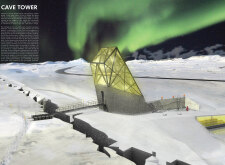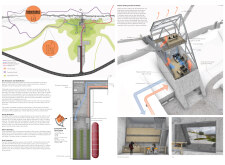5 key facts about this project
The Cave Tower is located in Iceland at the Grjótagjá site, an area known for its unique geological characteristics, such as volcanic activity and tectonic processes. This structure serves as a visitor center and aims to enhance the experience of the landscape while promoting ecological sustainability. The design reflects the natural forces present in the environment, integrating the tower into the surrounding terrain and highlighting the connection between architecture and geology.
Design Concept
Emerging from the mineral landscape, the Cave Tower captures the essence of the geological forces that shape the site. It functions not only as a place for visitors to gather but also as a way to modify the habitat. Paths leading to the tower, caves, and fissures are designed to guide visitors without harming the delicate surroundings, allowing for an engaging experience that respects the natural environment.
Sustainability Features
The design incorporates features that support sustainability and resource management. Passive heating and air circulation systems create a comfortable atmosphere within the tower. By placing platforms away from the walls, natural light and airflow are enhanced. Additionally, water management systems capture rainwater and store it in buried cisterns for various uses, ensuring that all resources are utilized efficiently.
Energy Generation and Food Production
Renewable energy plays a key role in the operation of the Cave Tower. Archimedes 750D turbines are used to generate electricity by harnessing the predominant North Western winds. This energy source covers the essential functions of the tower and decreases reliance on outside energy. The presence of a south-facing greenhouse allows for growing organic crops throughout the year. Wind energy is also employed to provide additional lighting as needed.
Site Restoration and Engagement
Attention to site restoration is an important aspect of the design. Previously compacted areas are restored through soil loosening and the introduction of diverse native plant species, enhancing overall ecological health. Stone markers measure the distance between the North American and Eurasian Plates, offering visitors an opportunity to engage with the geological story of the region and understand its significance.
A gently sloped pathway leads visitors through the site, concluding at observation points that provide broad views of the surrounding landscape. This layout encourages visitors to connect with the geological context of Iceland, deepening their appreciation for the natural beauty of the area.






















































